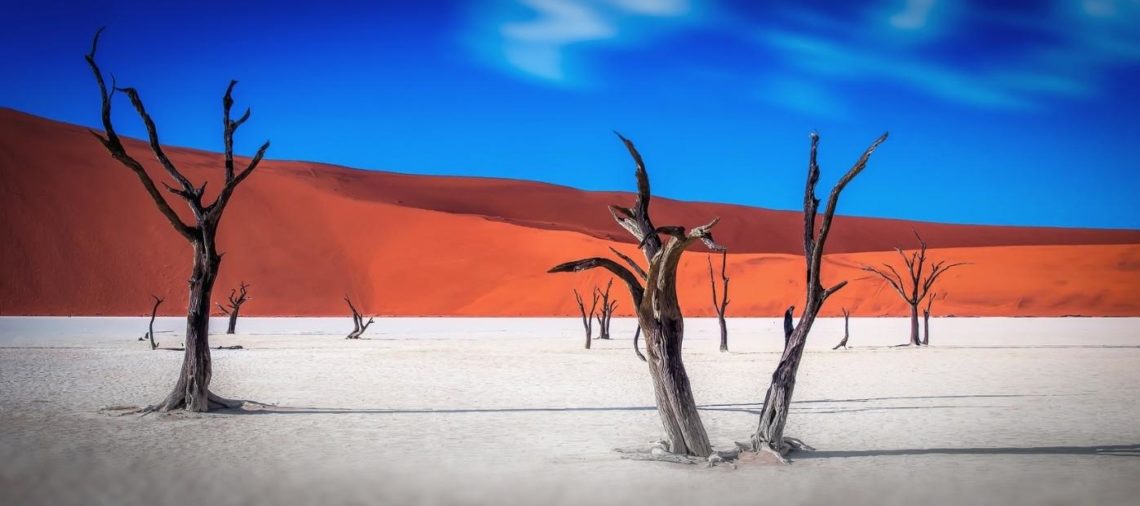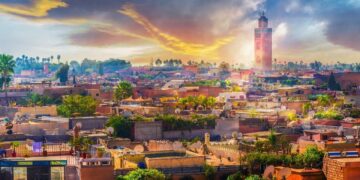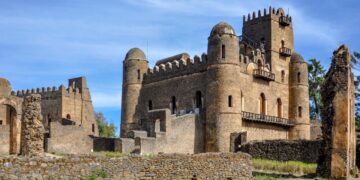In the heart of southern Africa, Namibia offers splendid panoramas between arid deserts, steep coasts beaten by the waves, and sand dunes undulating to infinity. Spot cheetahs on safari in Etosha, learn about the history of the world from the petroglyphs of Twyfelfontein, or try your hand at sandboarding in Swakopmund. A visit in Namibia is a delight to the spirit, so it’s good to know about the main famous tourist attractions in Namibia from the start, so you understand where to go. What to do and see in Namibia – here’s a mini-guide for those wishing to visit this magical land.
This wonderfully wild country is one of the few on the planet that still offers an immersive experience away from mass tourism.
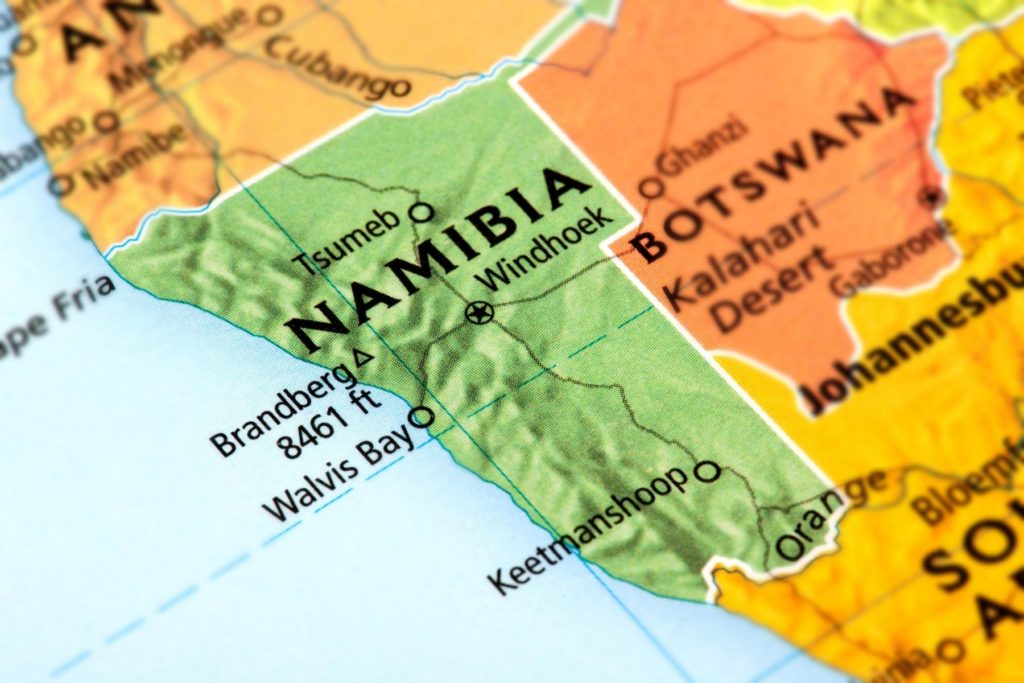
Swakopmund, also known as the summer capital of Namibia, is located in the western part of the country. It is famous for its German-inspired architecture and is one of the favorite destinations of tourists to Namibia, being the ideal place for extreme sports, paragliding, etc.
Namibia’s largest urban center is Windhoek, a city located in the middle of the country, which since 1990 has been the country’s capital. Windhoek is home to important academic and cultural centers, such as the citadel housing the National Museum, the seat of government, and the Lutheran Church built in the early 20th century.
At the same time, the Warehouse Theatre is the venue for the latest theatrical performances. Although it has a population density of only 2.54 inhabitants/km², nationally, Namibia’s capital and northeastern regions concentrate most of the country’s population. In contrast, small tribal people inhabit the south and west.
The Namib Desert – this ‘sea of sand’ – can be the source of some truly exciting experiences, and safari expeditions among lions, elephants, and rhinos are a real challenge. Namibia’s coast is one of the most beautiful places you’ll ever see, where you can watch whole colonies of seals gather on nearby islands. And here you can find other vision for 10 amazing highlights of Namibia.
- Tourist attractions in Namibia
- Map with the famous tourist attractions in Namibia (zoom for details)
- Sossusvlei
- Deadvlei
- Etosha National Park
- Swakopmund
- Pelican Point
- Skeleton Coast
- Fish River Canyon
- Windhoek
- Twyfelfontein
- Kaokoland
- Kolmanskop
- Tips for a trip to Namibia. What to avoid doing if you go to Namibia
- Conclusion
- Pin it!
Tourist attractions in Namibia
Map with the famous tourist attractions in Namibia (zoom for details)
Sossusvlei
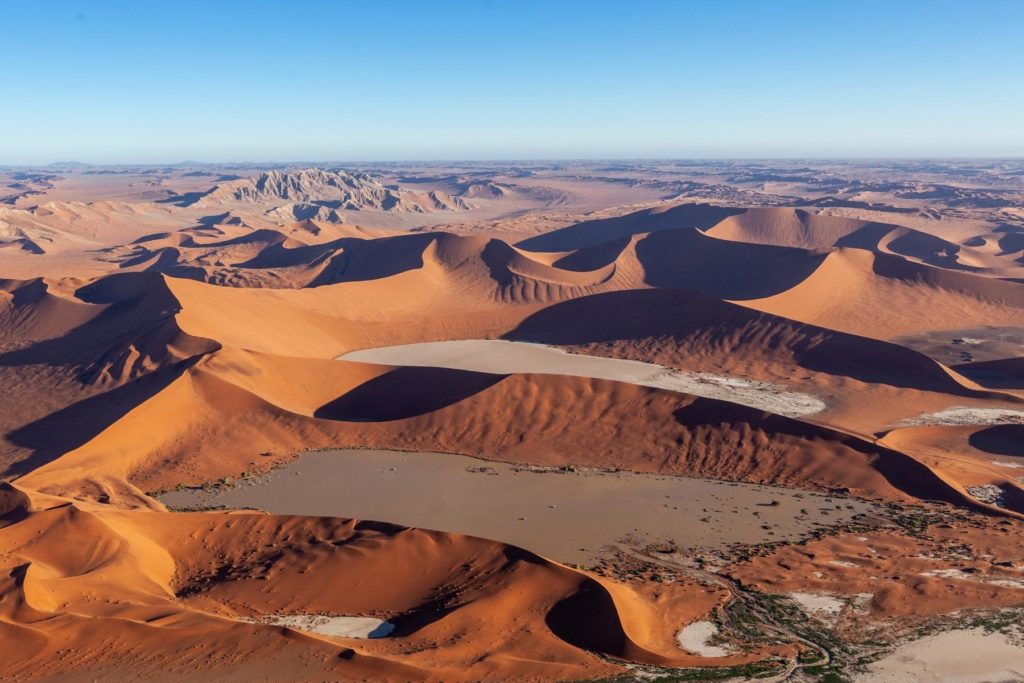
There is no way to describe the mind-blowing beauty of the Namib Desert, one of the oldest, most pristine, and most rugged landscapes on earth, formed 55 million years ago. Despite all these years, its wild, rugged splendor remains unchanged. Time has forgotten this land… a place where time stands still and enchanting beauty surrounds you at all times.
Looking for accommodation in Sossusvlei? Here are the best options!
As Namibia’s most famous and spectacular attraction, Sossusvlei is situated within the Namib-Naukluft National Park, Africa’s largest conservation area. Due to its high dunes, almost 400 meters high, and the beautiful morning and evening light, this area is a wonderful place for photographers.
With its large, white, salt and clay pan and giant red dunes surrounding it, Sossusvlei is a popular destination all year.
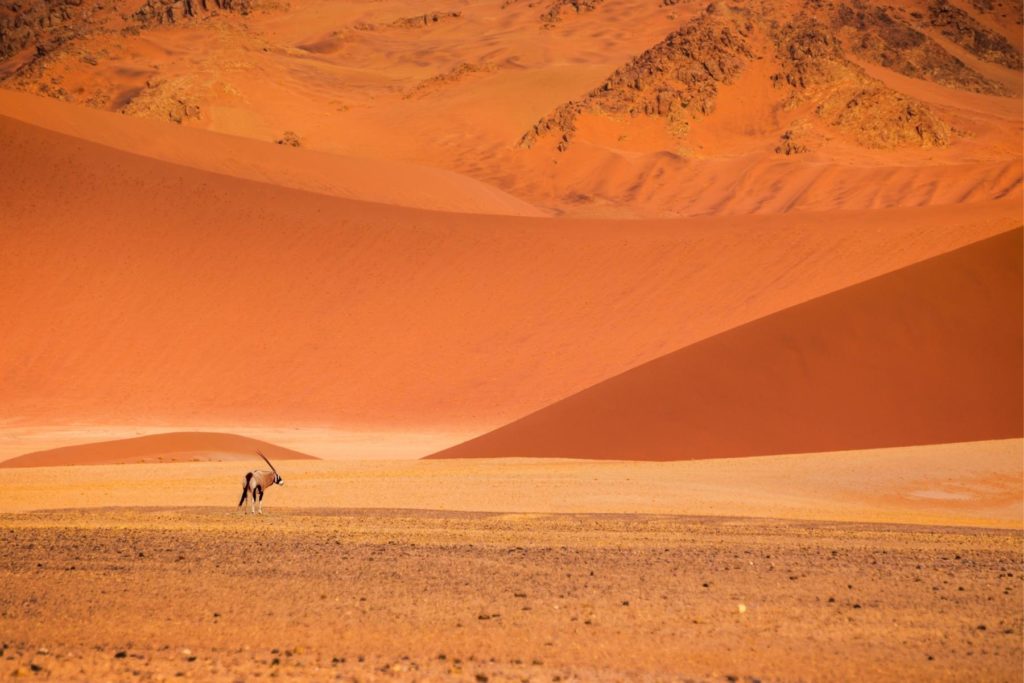
Located approximately 60km east of the Atlantic Ocean, Sossusvlei literally translates as “dead-end marsh” since the dunes stop the Tsauchab River from flowing further. Due to the dry conditions in the Namib Desert, the river rarely flows this far, and the pan remains bone dry most of the time.
During the rainy season, the Tsauchab fills the pan, attracting visitors from around the globe. Those passionate about photography will enjoy a glassy “lake” that reflects the surrounding dunes. Water can be stored in the pan for as long as a year after it fills. African animals come to drink, including desert-adapted elephants and a wide variety of birds. It is a piece of desert magic and a remarkable sight.
Despite the 65-kilometer drive to Sossusvlei being tarred, all but the last 5 kilometers are easily accessible. If you don’t have a 4WD vehicle, shuttles can take you the last 5 kilometers.
Unfortunately, Sossusvlei is usually flooded only once a year. It is impossible to time a visit to coincide with this flood. It takes a lot of luck to be in Sossusvlei at the right time.
Some people are in the Namib Desert at the right time to see Sossusvlei. But the desert turns into a swamp, and they cannot reach this place of plenty. Elephants can cross the water, but most vehicles cannot.
Deadvlei
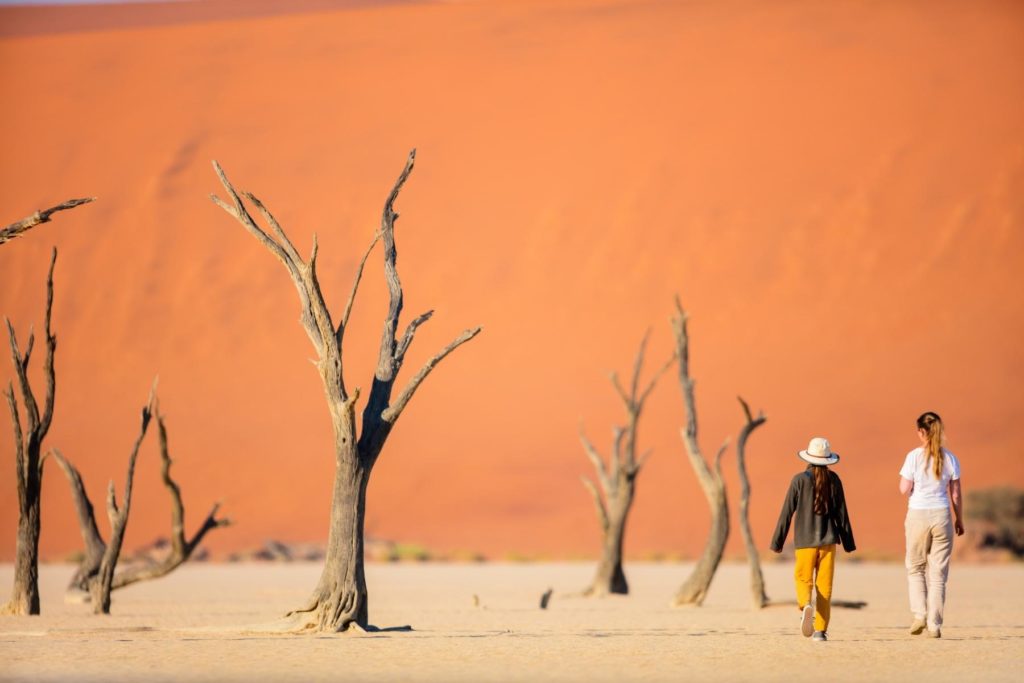
One of the most popular tourist attractions in Namibia is the Deadvlei, which has been used as a backdrop for many movies and commercials. Take your camera to photograph the white clay bowl, red dunes, calcified acacia trees, and blue sky. The shot is unmissable.
Between the skeletal black trees, the white ground, the reddish dunes, and the intense blue sky, the contrast is striking and gives incredible images. But one can only realize the site’s grandeur by going there. The images are always of another dimension in real life. Pictures of the trees and dunes, as beautiful as they are, cannot do justice to Deadvlei and prepare you for its size.
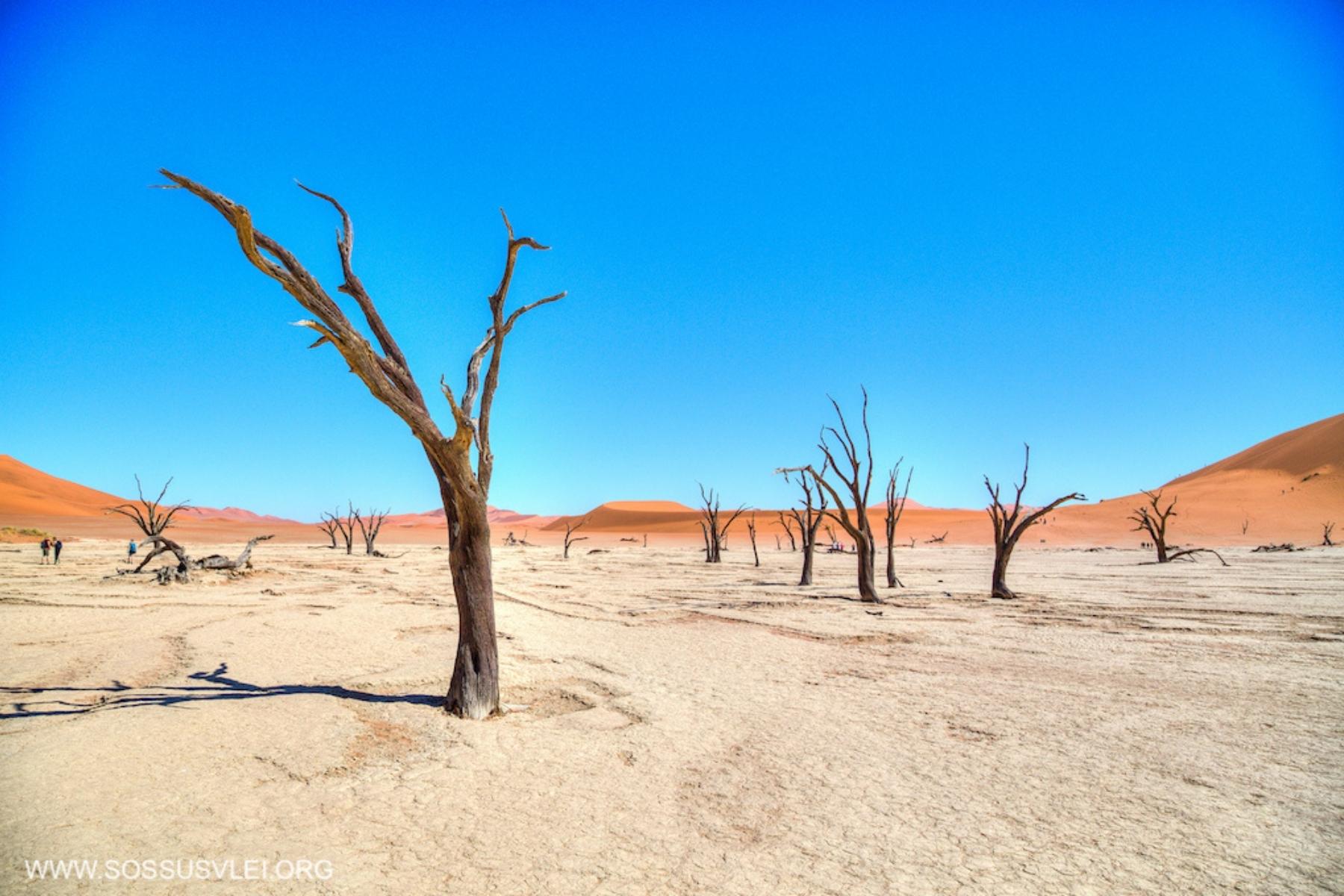
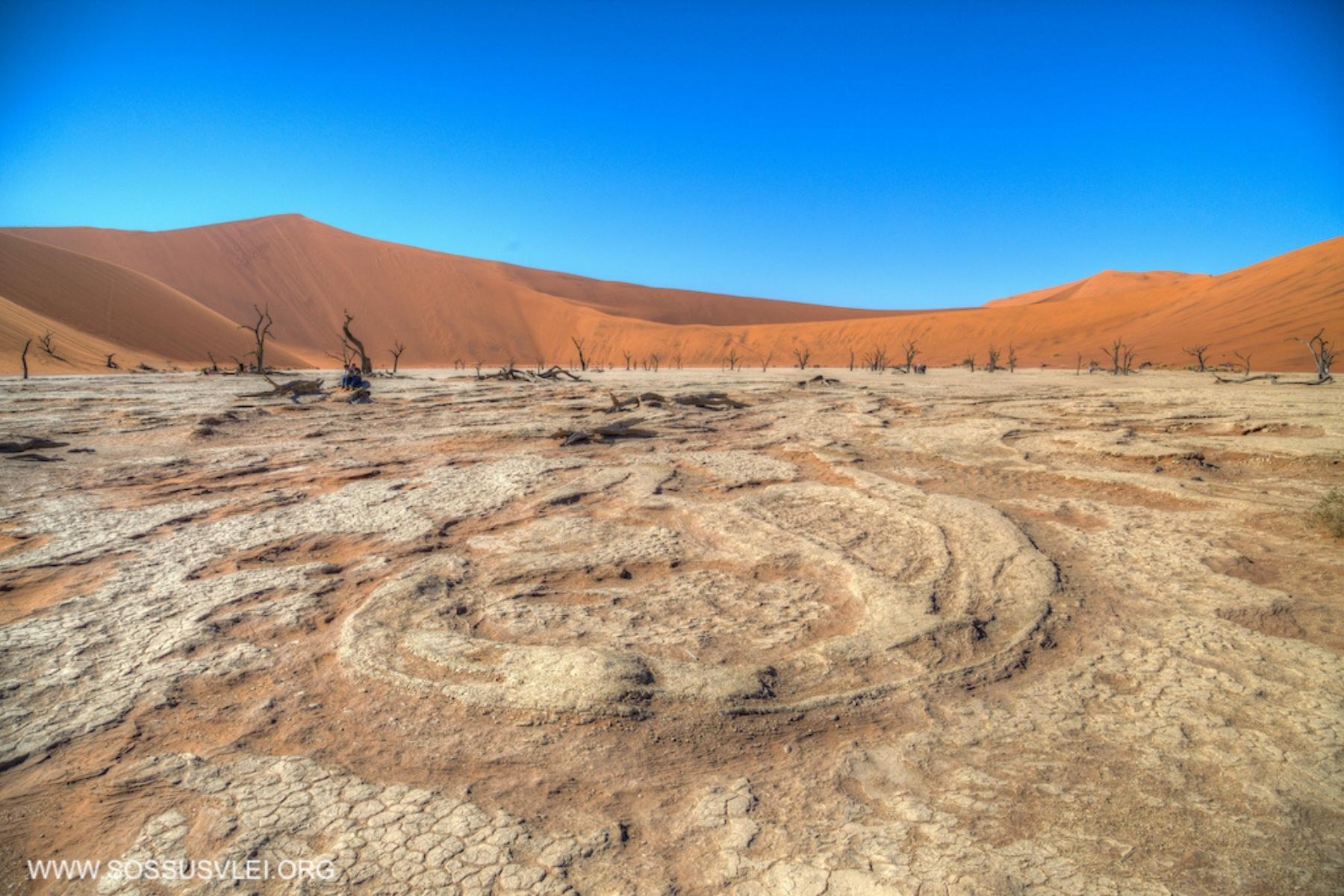
Its name is also spelled Dead Vlei and means “dead swamp” (from the English dead, and the Afrikaans vlei, “swamp” or “lake”).
Sesriem
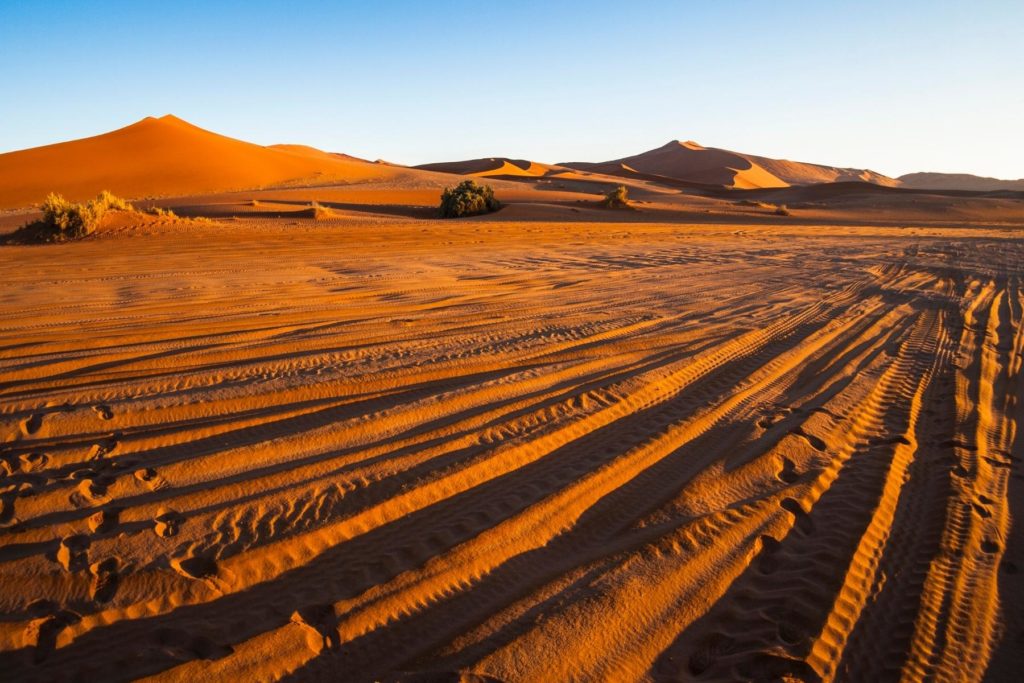
The first stop to get to Deadvlei is Sesriem, where the entrance to the Namib-Naukluft Park is located. From Windhoek, it takes about 4 to 5 hours of driving (mostly in the desert). Once in Sesriem, there is no possibility of getting lost. The entrance to the park is located near the only gas station in Sesriem (you may want to take advantage of this to refuel if you are by car).
To enter the park, you will have to pay an entrance fee. In 2022, this was about 9 USD per adult, 6 USD, and 3 USD per vehicle, up to 10 seats.
Big Daddy and Dune 45
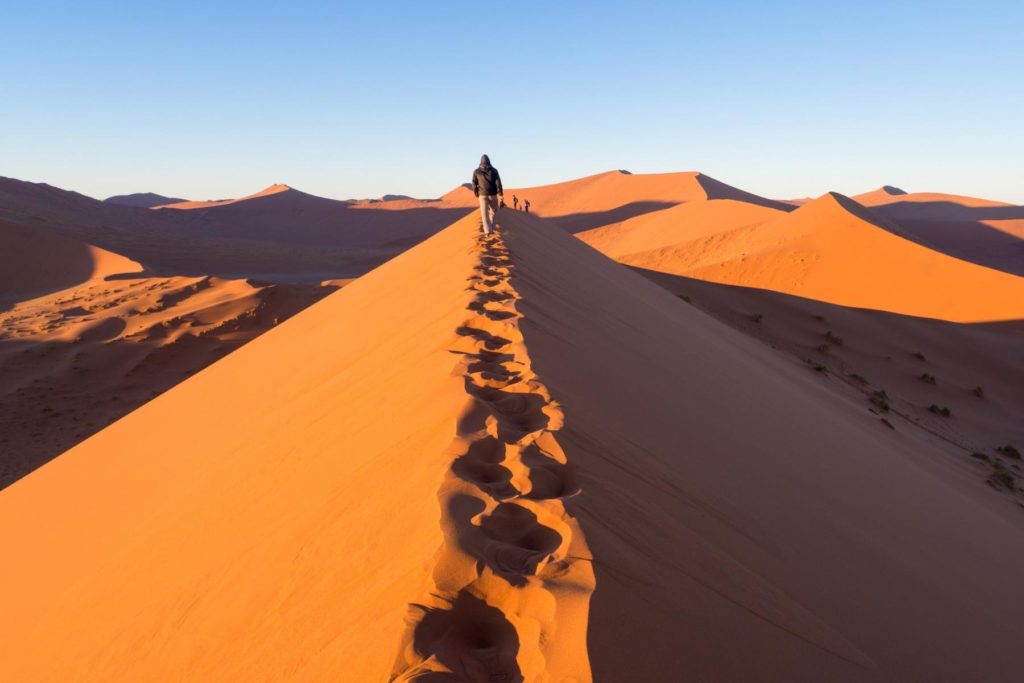
Once in the park, it takes about one hour to reach Dune 45, which is 45 km from the entrance. To get to Deadvlei, drive past Dune 45 to the next parking lot. Most visitors leave their cars there and take a 4×4 shuttle. This is because the last 2 km to Deadvlei is all sandy roads in the middle of the dunes, and unless you are an experienced driver and have an excellent vehicle, you are likely to get stuck. It will cost you about 11 USD per person.
Some almost 400-meter-high sand dunes are in the Namib Desert, making it one of the world’s highest deserts. Although there are countless dunes of varying heights to choose from, most people flock to Big Daddy and Dune 45. No matter your age or ability, you can climb the highest peak or hike partway, slide down the side, or simply admire the cascading dunes below vlei.
Spend at least one night inside the park and try to catch the sunrise from the top of Big Daddy Dune.
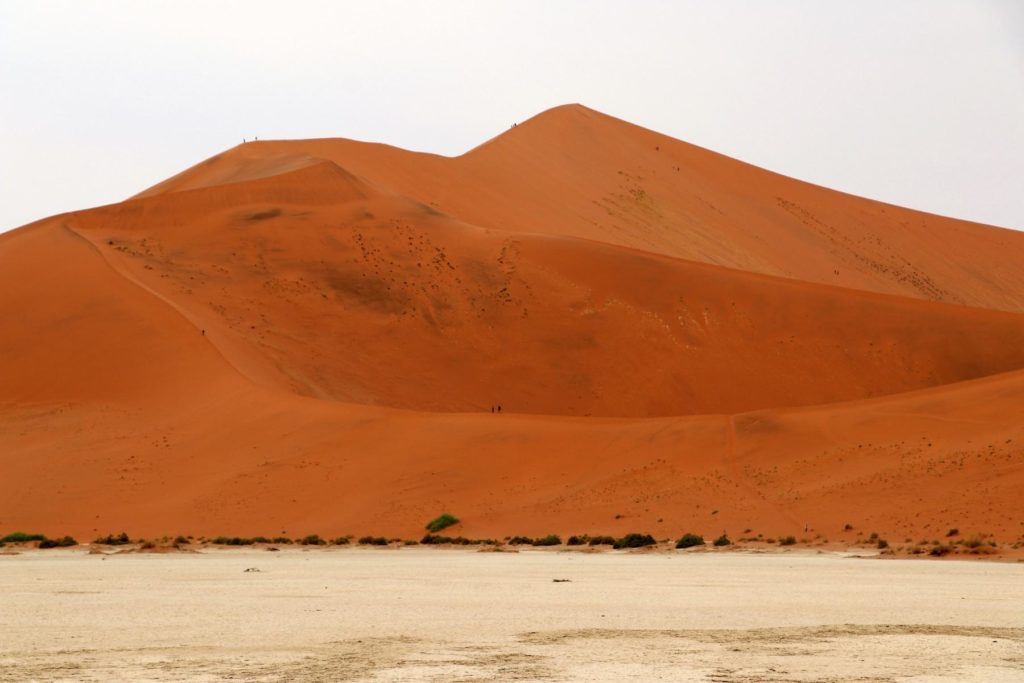
Upon arrival, the suggestion is that you start by climbing Big Daddy, the highest dune in the region at 325 meters. Big Daddy is located between Sossusvlei and Deadvlei. Once on top of the dune, you can enjoy an exceptional view of Deadvlei. Then you can run down the slope in the sand to reach its heart. An unforgettable experience!
Even though Big Daddy stands at 325 meters, it is not the highest dune in the Namib Desert. Dune 7, which measures 388m, receives this honor. Along the Tsauchab River, Dune 7 is the 7th dune, therefore its name.
As for Dune 45, its name comes from its proximity to the Sesriem Gate. 45km away from the gate along a paved road, it can easily be reached by a 2×4. Due to its intriguing shape and accessibility, it is the world’s most photographed dune.
You can climb Dune 45, so go early in the morning to see the sunrise over the vlei. You will be spoilt with a stunning panoramic view of the Dune Valley from the top of the 85-meter-high dune. An amazing sight to behold in the morning and evening light is the pan’s surface, which appears like a “moonscape.”
The wind carried sand from Namibia’s coast to create the dunes of the Namib Desert. Due to the iron oxide content in the sand, it is red in color. Lighting and the appearance of the dunes’ characteristic color change with time of day, making them interesting to photograph at any time.
Sossusvlei’s dunes are referred to as “star dunes” because the wind blows them from all directions. As a result, the winds cause the sand to form multiple arms in a star shape.
You can then reach Sossusvlei, 1 km away, and continue your expedition. Don’t forget to bring plenty of water, good sun cream, a hat, good shoes and light and covering clothes. The conditions in the desert can be particularly challenging.
The majority of accommodation in the area is in or around Sesriem (in the middle of the desert). Whether you are a Namibian camper or a five-star hotel guest, there is something for everyone. If you want to stay in Namib-Naukluft Park, there is only one option, the Sossus Dune Lodge. It has the huge advantage that it offers its guests the possibility to reach Sossusvlei and Deadvlei before the park’s opening to the general public.
Some of the accommodations are located within a few dozen kilometers of Sesriem. If you don’t mind driving a little bit, this can be a good idea to ensure a peaceful retreat and save on the nightly rate.
Etosha National Park
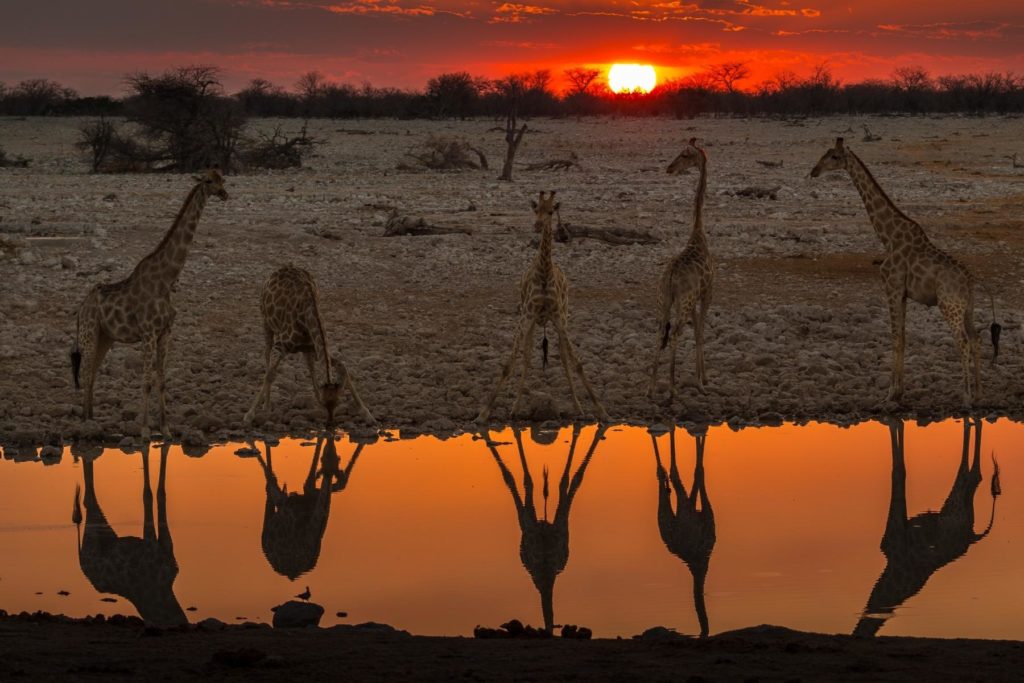
What to see and do in Namibia at all costs? Etosha National Park, without fail. It is one of the major tourist attractions in Namibia. The safari promises to be unforgettable in this preserved space of about 22,000 hectares, of which only a third is open to the public. Don’t worry; there is plenty to do! 114 species of mammals and 340 species of birds live there in total freedom.
You will meet elephants, zebras, wildebeests, springboks, lions, oryx, giraffes, kudus, rhinos, and many others. Only the buffalo is missing to be considered a “Big Five” park. In addition, the gravel tracks are in really good condition. You can drive through the park in your own vehicle without any problems.
By choosing this option, you will get a little more freedom. But be aware that it is essential to respect the driving rules. For example, the speed limit is 60km/h. It is also strictly forbidden to leave the tracks and your vehicle. Your safety and that of the animals are at stake.
In the local Ovambo language, Etosha translates as “big white place.” And for a good reason! The Etosha Pan is logically the main attraction of the park. It is a huge white expanse that covers about 4,800 km², almost a quarter of the park. At 130 km long and up to 50 km wide, it is the largest salt pan in Africa and is even visible from space.
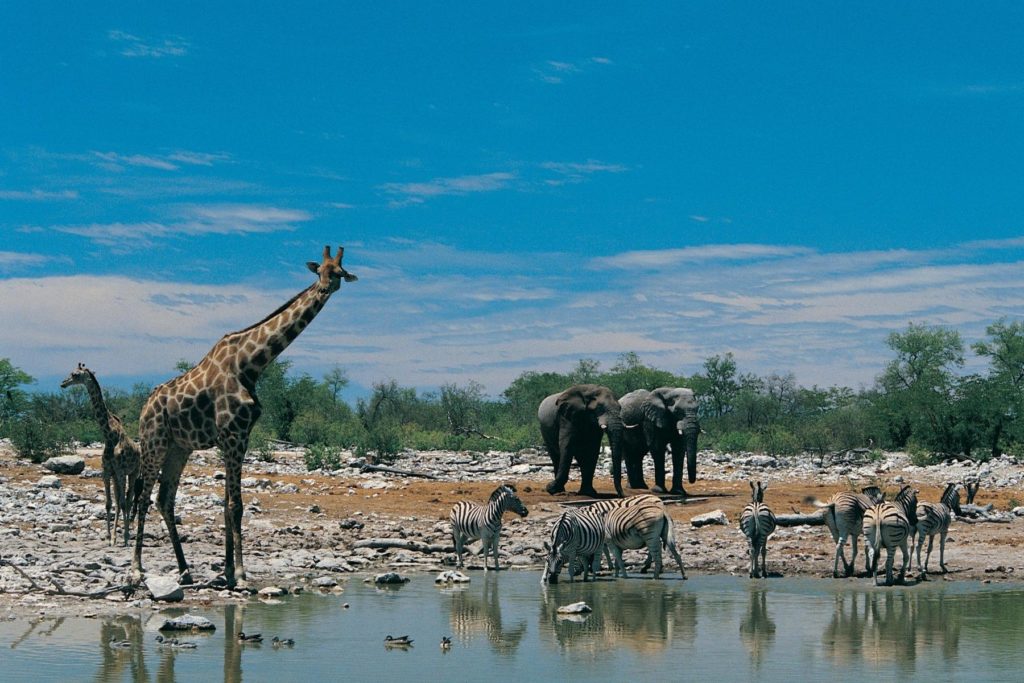
Specialists estimate that this pan was formed more than 100 million years ago. About 16,000 years ago, the Kunene River, which originates in Angola, flowed to Etosha. Over the centuries, it became a vast, deep lake. But due to the movement of tectonic plates, the river was diverted and took the direction of the Atlantic. The lake then began slowly drying up, leaving the salt marsh we know today.
You can sleep in the park, lodges, and campsites welcome you under a starry sky, in a silence only broken by the cackling of hyenas. A magical night that will remain engraved in your memory for a long time, no doubt about it! It is recommended that you go near the waterholes, early in the morning or late in the day – when it is less hot – to have a better chance of spotting them.
The park can be visited all year round, even if the dry season during the southern winter (June to October with a peak between July and September) is favored if you wish to see many mammals. Indeed, they are more easily observable around the rare water points, the sparse vegetation helping.
The rainy season, between November and May, and especially between December and March, is considered less good for observing animals, which tend to disperse, as water is present in most of the park. It is, however, a very good season for observing migratory birds, especially pink flamingos.
Swakopmund
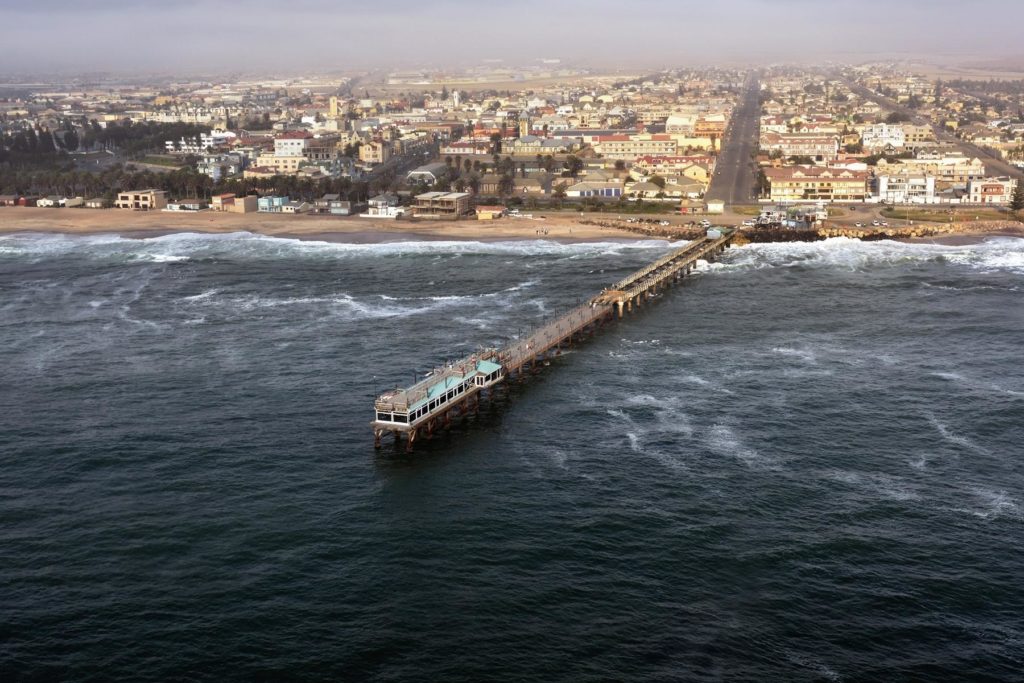
Located on the country’s Atlantic coast, Swakopmund is a small seaside resort that forms the gateway to the Skeleton coast, which we will tell you about next.
First of all, it should be noted that Swakopmund enjoys an ideal location. It is located halfway between the extraordinary Namib Desert and the magnificent Damaraland region, two key stages of a trip in Namibia. The distances being significant in Namibia, Swakopmund is an almost obligatory stage to connect these two exceptional regions. After several days in the desert or the heart of the Namibian bush, this coastal city has a real oasis of air! Moreover, this charming town is only a 3h30 drive from Windhoek and the small town of Walvis Bay, located 40km away, has an international airport, so it is very easily accessible.
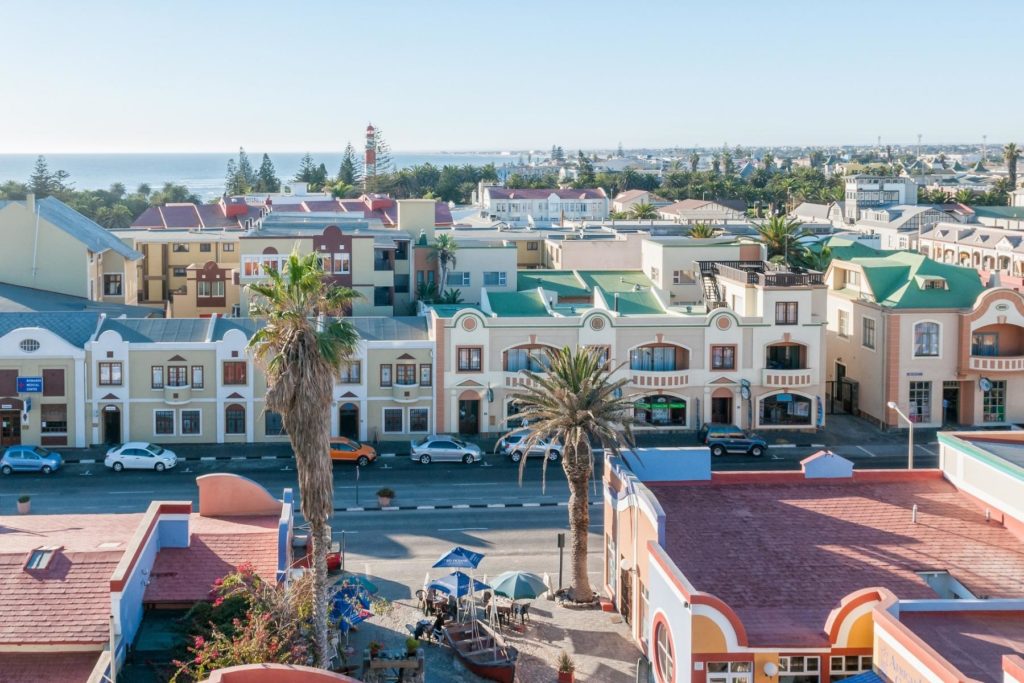
Start by strolling through the city’s quiet streets to contemplate the facade of Woermann Haus – a beautiful German colonial house – or push the museum doors to learn more about the local history, fauna, and flora.
Woermann House was built to be the headquarters of the Damara & Namaqua Trading Company and proved useful as a landmark for ships approaching the coast. In the mid-twentieth century, it was converted into a school and later into a library and art center, which it occupies today.
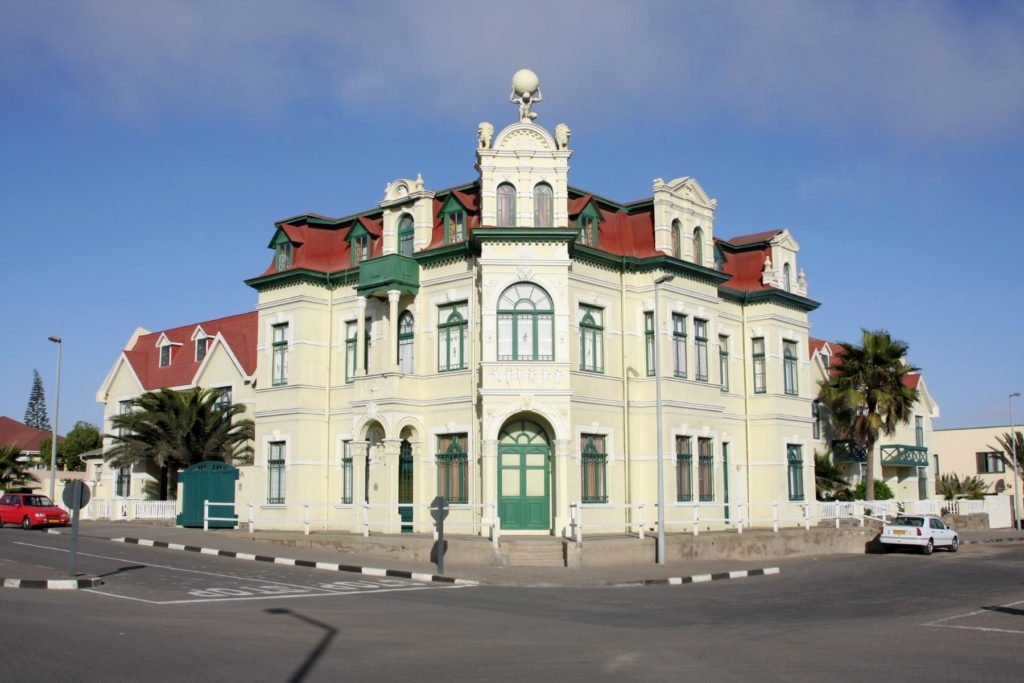
But the best part of Swakopmund is to get out into the surrounding area and surf the sand dunes that rise from the ocean. Once on top, you will enjoy a sumptuous panorama before going down at full speed on your board.
And if you prefer more leisurely activities, don’t hesitate to take advantage of Swakopmund’s beautiful beach. It is bordered by Beira Mar, a promenade full of stores and small restaurants, which is perfect for an early evening stroll. You can also visit the Craft Market, a small art market dedicated to community development and support for artisans. An excellent opportunity to buy some souvenirs while doing a good deed!
Pelican Point
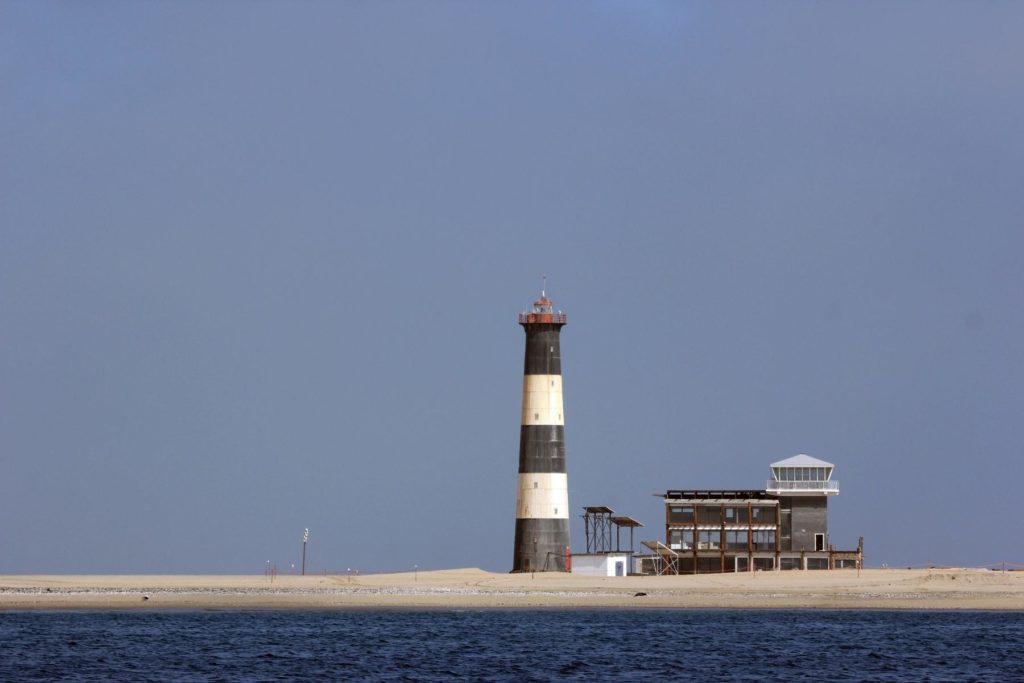
If you’re still wondering what to see and do in Namibia for a change of pace, how about a kayaking trip among the seals? An impressive colony of thousands of seals calls Walvis Bay and Pelican Point home, and you’ll be able to get as close as you can with your arms.
The smell is a bit disconcerting at first – not to say nauseating – but the mischievousness of the seals that come to play with you will quickly make you forget this slight inconvenience. Other animals spawn in the vicinity, such as the poetic pink flamingos, curious jackals, or the pelicans with their big goiter that gave their name to the place.
Skeleton Coast
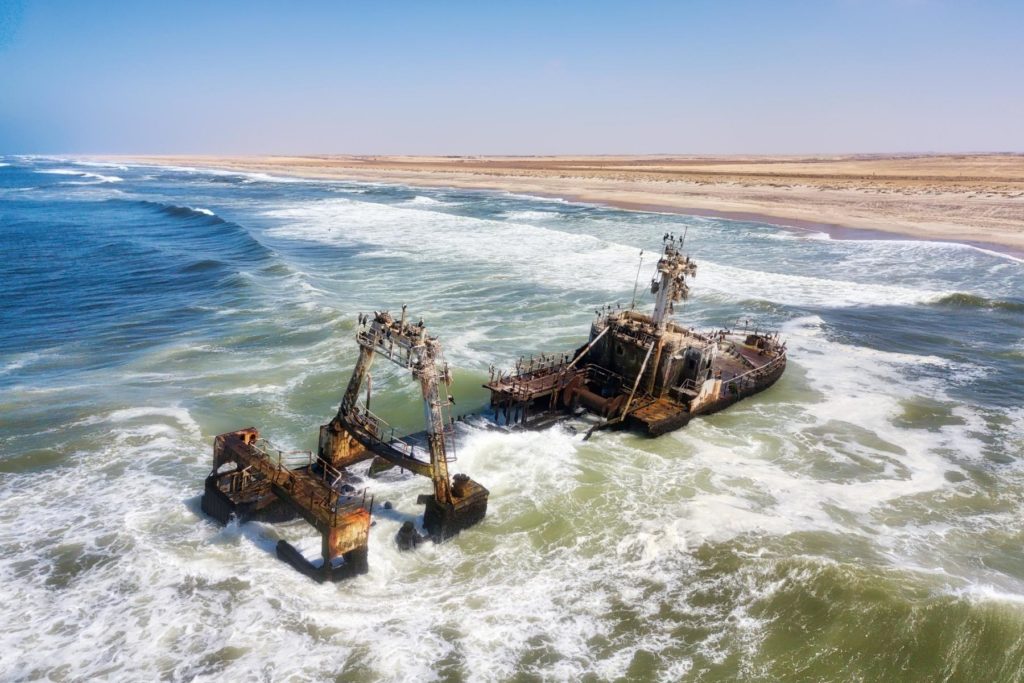
Skeleton Coast is undoubtedly one of the most surprising places to do in Namibia. It owes its name to a writer, John Henry Marsh, whose books tell the story of the sinking of a ship, the Dunedin Star. And there are ships all along the coast, which testify to the difficulty of coming to moor here.
Here and there, you’ll also find whale bones on the beaches, and budding birdwatchers can find nearly 250 species of birds in their binoculars. Two modes of transportation are available to visit the area: a helicopter tour, to fly over the region and take in the view, or the car (we recommend a 4×4, as the road is sometimes difficult to drive on specific sections, especially those on dirt).
Sandwich Harbour
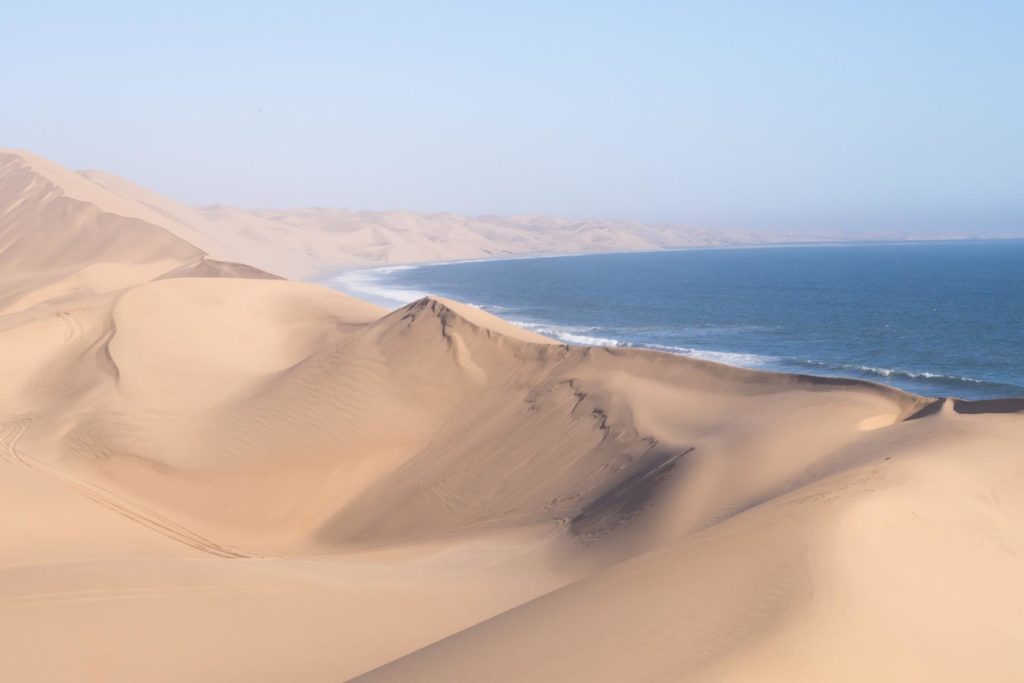
From Skeleton Coast, you can take a trip to Sandwich Harbour, which is one of the only places in the world where the desert meets the ocean, sometimes covered with a somewhat ghostly mist. The guide will probably take you to see a colony of flamingos that have taken up residence in the area or some antelopes, lizards, and geckos that live in the sand.
Fish River Canyon
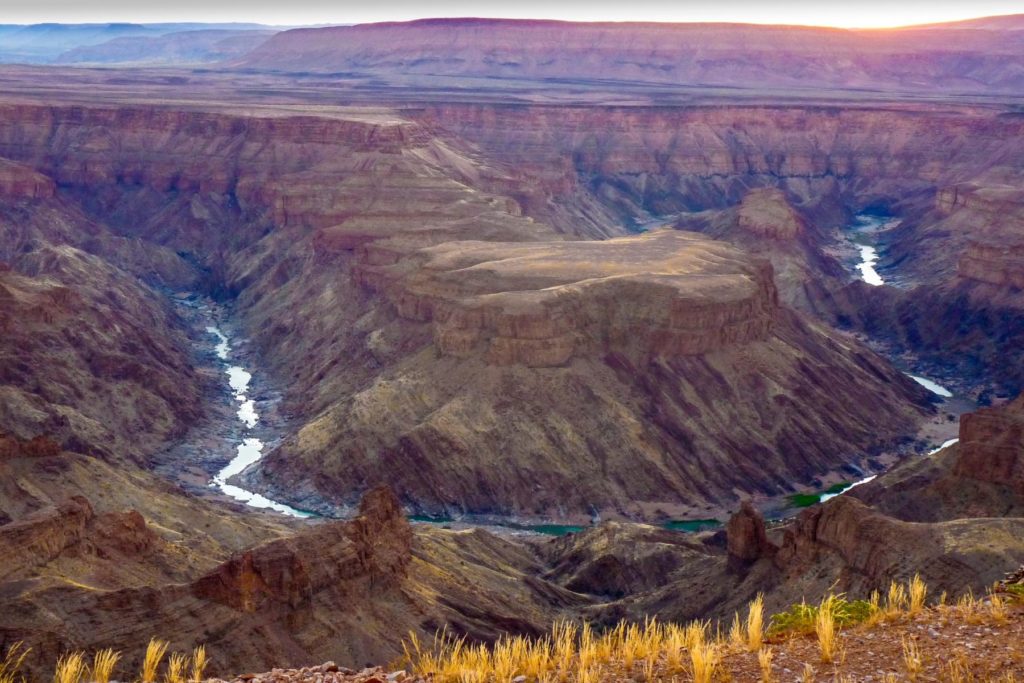
The second largest canyon in the world after the one in the United States, Fish River Canyon is a must-see if you plan to visit Namibia. On the border with South Africa, a natural jewel located in the extreme south of the country, it captures the imagination with its 160 kilometers long, 27 wide, and 550 meters deep.
The main activity in Fish River Canyon is, of course, to admire the view. Spectacular is probably the word that best describes it. Several viewpoints have been set up around the canyon to make the most of it. The main one is located in Hobas, but the others are just as impressive. It is possible to reach them by car, but the best way to enjoy them is probably on foot. Hiking is a very popular activity in the canyon.
The contemplative will go from viewpoints to viewpoints to enjoy exceptional landscapes. The most courageous will opt for the Fish River Hiking Trail, which will lead them to the bottom of the canyon through a walk of 85 kilometers in 3 to 5 days. Hot springs will allow you to relax while observing the faults dug by 2 million years of erosion.
It is possible to go on an adventure alone, but because there are no facilities for self-guided hikes, special care must be taken. You don’t want your trip to Namibia to go wrong! Safety rules are in force and must, of course, be respected at all times. If you opt for a guided hike, you can learn a lot more about the secrets of the Fish River Canyon and even rappel down to the bottom of the gorge! By far, the most famous hike is the Fish River Hiking Trail. It takes 3 to 5 days to complete and takes visitors 85 kilometers down into the canyon.
Windhoek
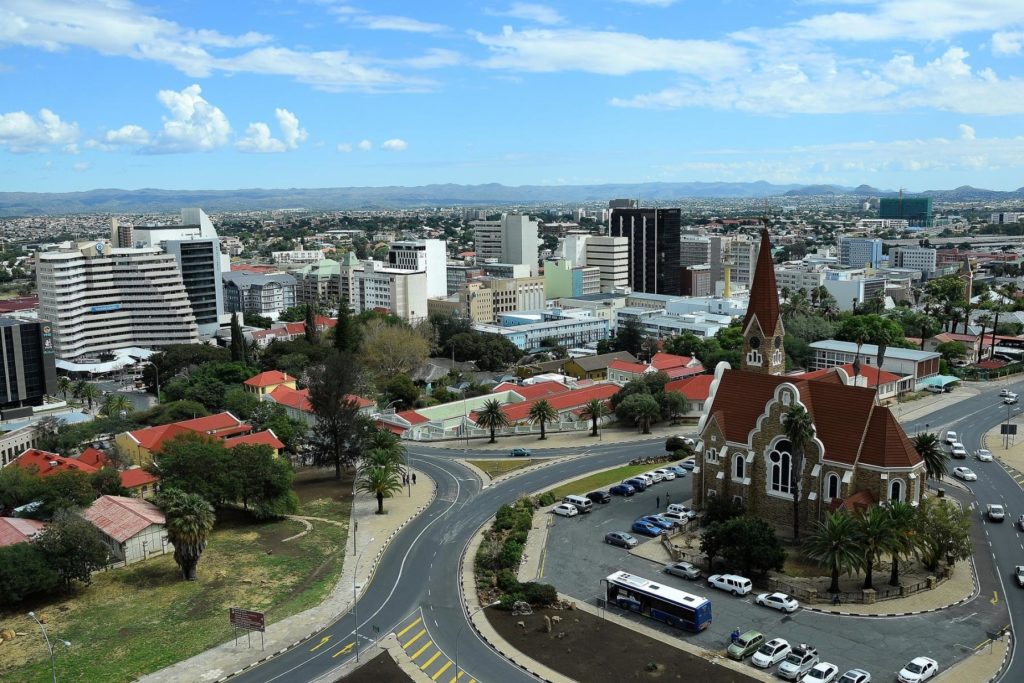
If you visit Namibia, you will probably land in the country’s capital, Windhoek. The city is particularly pleasant to discover. Located in the center of the country, at more than 1500 meters altitude, Windhoek will be the perfect place to start your journey since you can quickly reach many other sites of interest.
Looking for accommodation in Windhoek? Here are the best options!
The city’s emblem is the beautiful Lutheran church, built in 1910, on a central square. You can also visit several museums in the capital, such as the Independence Museum, which traces the difficult history of the country and the struggle of Namibians against the German colonists and South Africans.
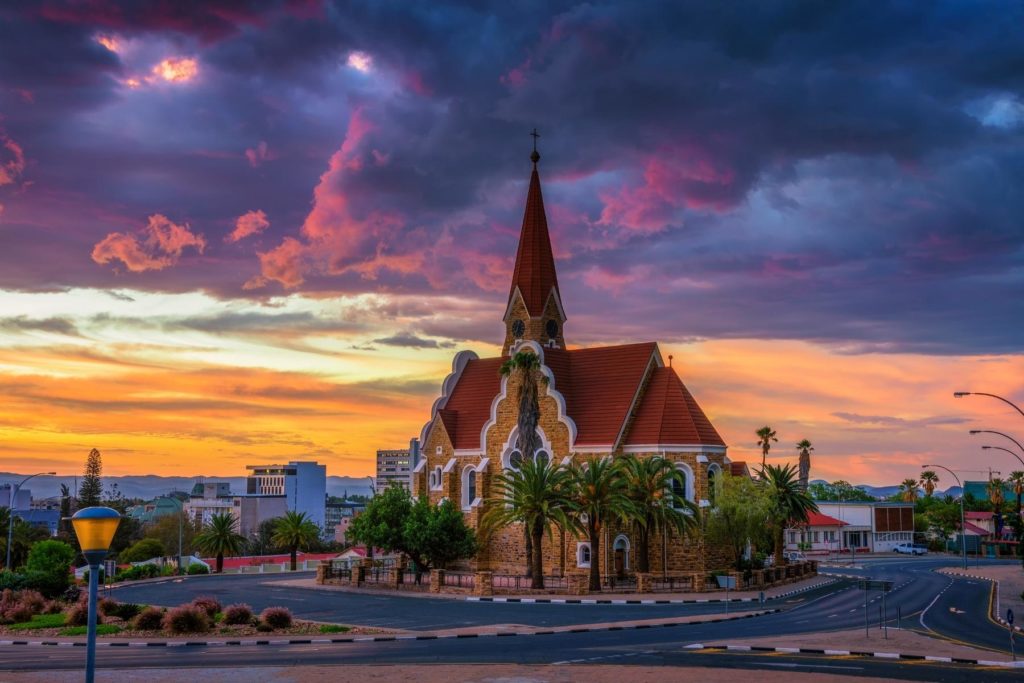
You will also have the opportunity to visit the Namibia Craft Center, where many of Namibia’s traditional crafts are made. There are 40 stores on site where you will find all the souvenirs you would look for in Namibia.
Twyfelfontein
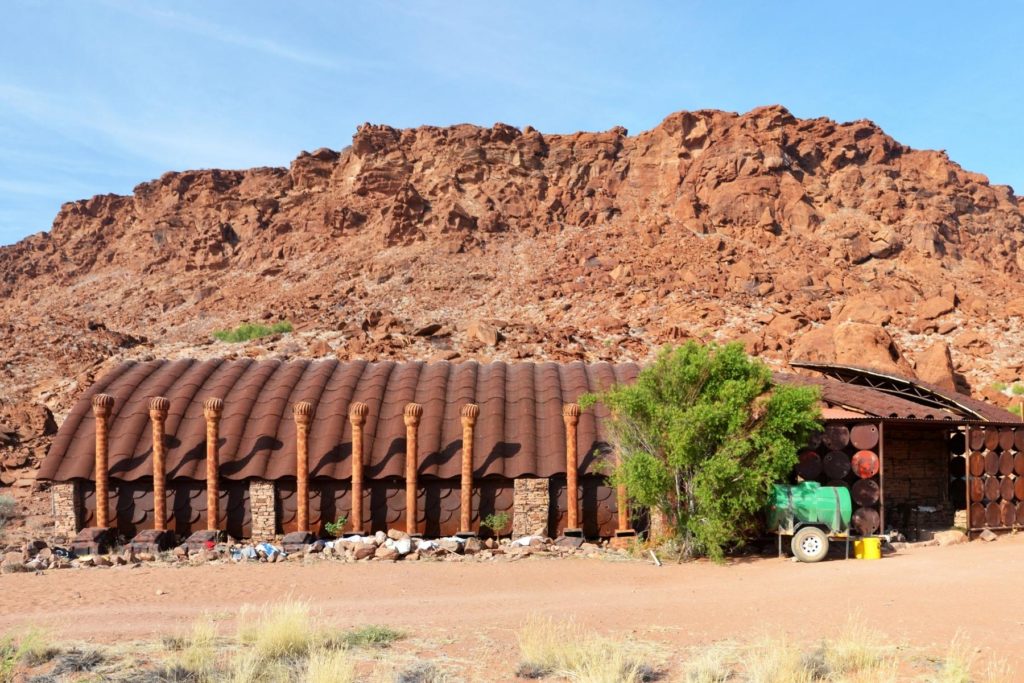
The site of Twyfelfontein (which means “uncertain source”) is home to one of the largest concentrations of rock engravings in Africa, thousands of years old. To discover these petroglyphs, you must follow the guide and let yourself be carried away in history. The animals are mostly represented, some very recognizable, others less so! One is easily caught in the game of guessing in front of these engravings, which testify of an important fauna in the past.
A few kilometers from there is the site of Organ Pipe. These basaltic organs are a curiosity to see and to combine with the area of Twyflefontein, as well as Burnt Mountain, an arid mountain that seems to have been literally burnt.
Kaokoland
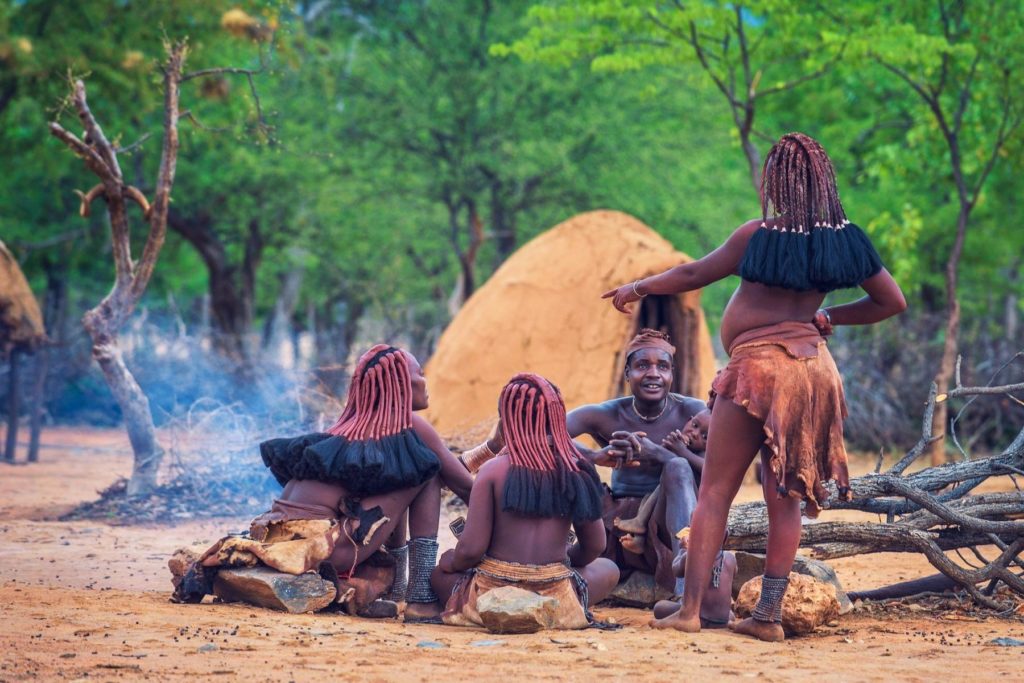
When you wonder what to do in Namibia, why not a detour to the country’s north to meet the Himbas inhabitants in Kaokoland? Associations organize guided tours in the villages, which will allow you to know more about the ancestral way of life of these Bantu tribes.
Here, the women dye their bodies and long braids red, using a mixture of ochre powder and grease, to protect their skin and hair from the sun and the harsh climate. They will be happy to share some of their cosmetic preparations’ recipes.
Kolmanskop
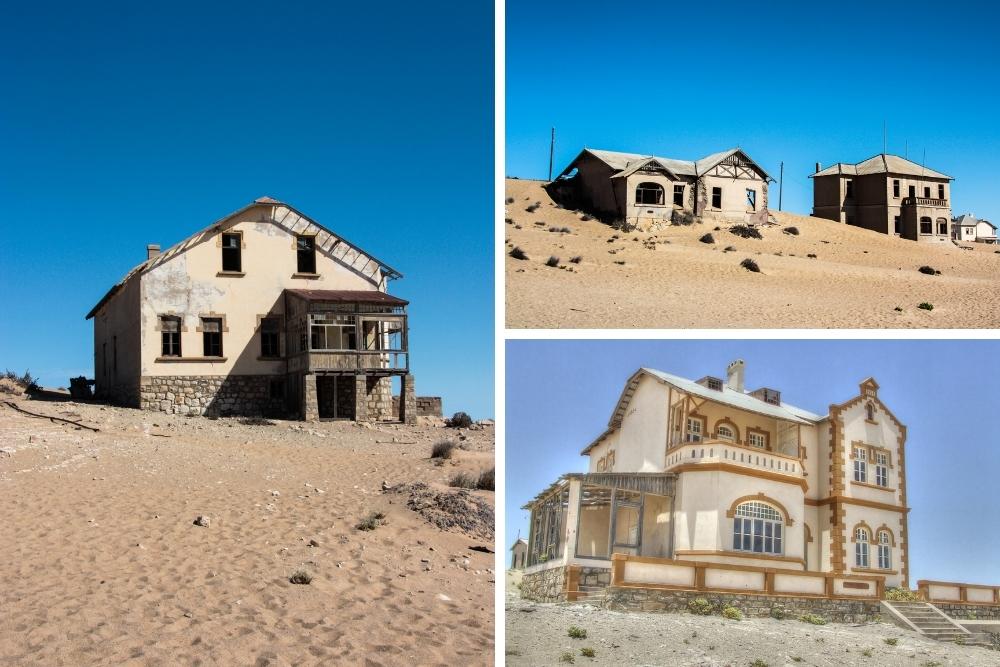
Lovers of unusual excursions, if you wonder what to see and do in Namibia, do not miss the Kolmanskop ghost town! It came out of the sand at the beginning of the 20th century, following the discovery of a diamond in the area, and for some time, it was home to families of miners searching for a juicy vein.
A casino, a hospital, and even a swimming pool were built before the village was depopulated in the 1930s in favor of more profitable mines. Today, one can explore the place, gradually invaded by the sand. Some pieces of furniture and a small museum will allow you to learn more about the history of Kolmanskop and its inhabitants.
Tips for a trip to Namibia. What to avoid doing if you go to Namibia
Generally speaking, Namibia does not present security problems, except in big cities like Windhoek or Swakopmund. Indeed, pickpocketing, physical attacks, and credit card scams are part of the crimes perpetrated by delinquents. It is, therefore, important to use common sense to avoid the risk of theft. For your safety, it is best not to walk alone at night, especially in deserted areas.
Caution rules in Namibia
Caution is also required on the roads because accidents are unfortunately frequent. Road safety rules and traffic regulations are not always respected. Driving at a moderate pace and keeping a certain distance from other vehicles is preferable. At night, wild animals sometimes roam the roads. This is because the light from headlights attracts them, which can be dangerous if you don’t spot them in time. Driving only during the day is safer, especially if you have long distances to cover. In addition, you often won’t see anyone for several miles when you leave the city. Although the risks are minimal, you are not safe from being mugged.
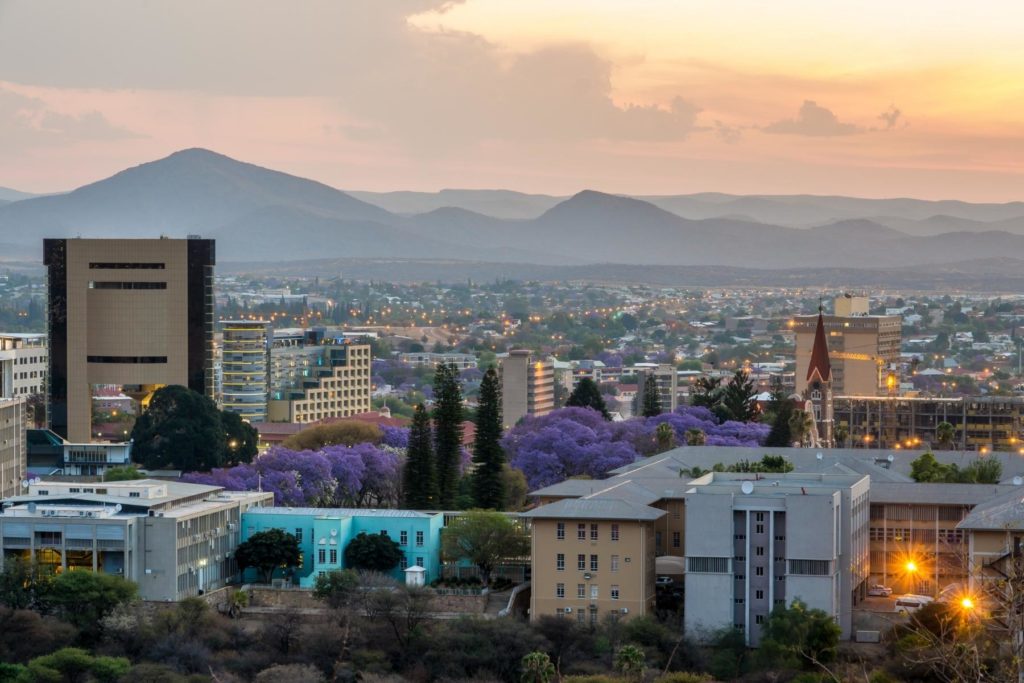
Overall, the risks are reduced when you move away from the big cities. Wherever you go, keep your attire simple and avoid the typical tourist look. Do not carry valuable jewelry or handle your digital devices in public spaces. Applying a few elementary rules of good sense will allow you to realize a Namibia tour far from the potential dangers.
Namibia is one of the countries where one should pay special attention to food hygiene. As far as possible, one should avoid drinking tap water, ice cubes, and even more unsealed fruit juice and eat raw food.
Because of the heat and the very dry climate, travelers are advised to drink a lot of bottled water and to be careful about dehydration.
Another genuine threat is the risk of transmission of STDs/AIDS. So don’t ignore all available means of protection, including condoms.
When to visit Namibia?
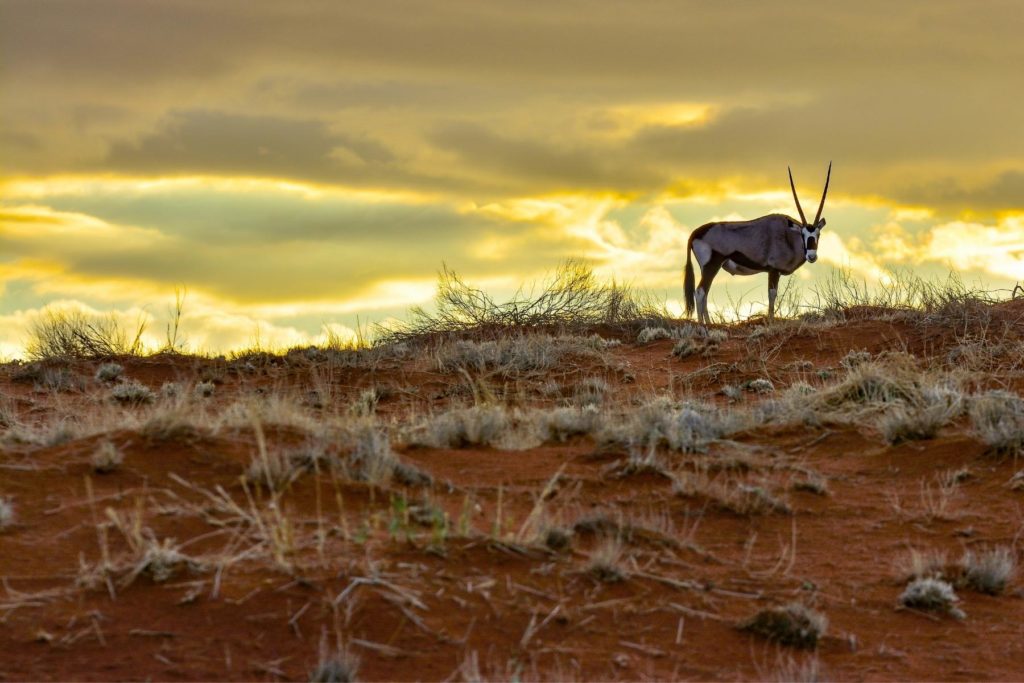
The climate is a source of some natural hazards in Namibia. During the rainy season, unpaved roads are often completely impassable. Heavy rains also tend to cause flooding, even in urban areas. For this reason, it is best to plan a trip during the dry season, especially if you want to enjoy the country’s beautiful natural sites.
Generally speaking, Namibia has three main seasons:
- The winter, from May to September
- The hot and dry summer from October to December
- The rainy season from January to April
Drought is also a danger in Namibia, which is a semi-arid country. The heat is intense, and finding fresh food in the affected areas can be difficult, if not impossible.
Namibia has a typical desert climate with some variations depending on the terrain. The Namib desert region has significant temperature variations in summer, with peaks of 40°C during the day and a minimum of 0°C at night. During the winter, the desert is heated by easterly winds, which often cause large sand devils. Inland, the winter is mild and dry, while the summer is humid and very hot.
Namibia’s culture
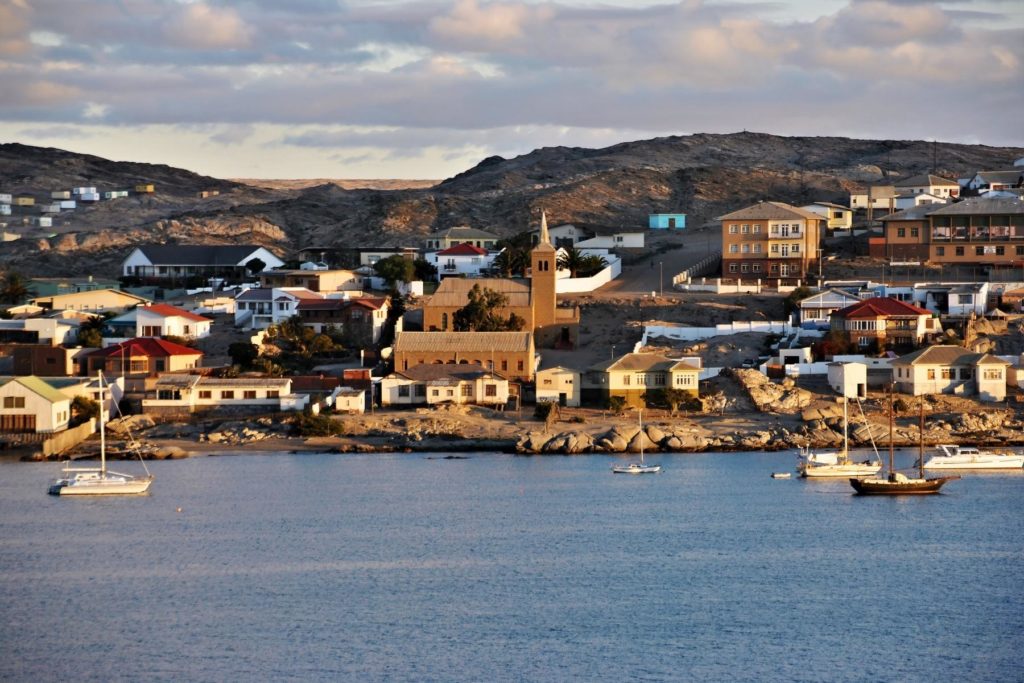
Namibia is one of the few countries colonized by the Germans. That’s why cities like Windhoek, Swakopmund, or Lüderitz are marked by German and Dutch culture, especially through colonial architecture. But as Namibia is a relatively new country, the traditions of the dozens of ethnic groups that make up the local population are still very present. Dances, songs, sculptures, and tales that are inseparable from the African oral tradition, as well as the cult of the ancestors, occupy a great place, especially among the Himba.
Conclusion
Namibia is a country in West Africa that will not leave anyone indifferent, that’s for sure! During safaris or excursions in the wilderness, you will discover varied landscapes and rich fauna. You will also have the opportunity to visit unforgettable sites in an original way. Do you have any other tourist attractions in Namibia that you recommend? Mention it in the comments for our readers!
Pin it!
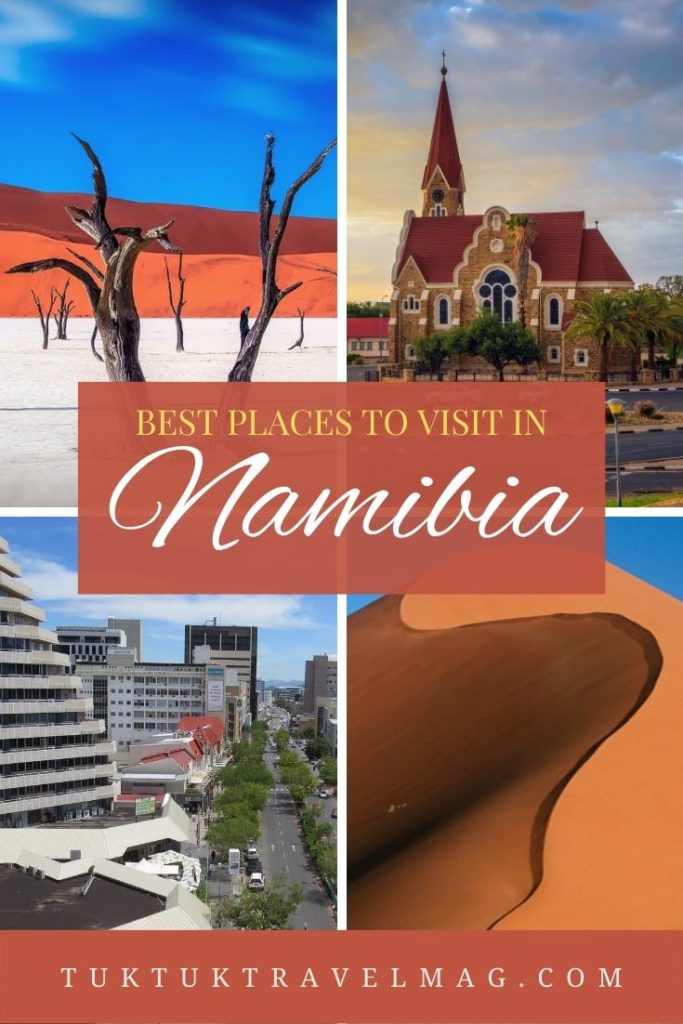
You may also like: Top 5 African countries for admiring wildlife

